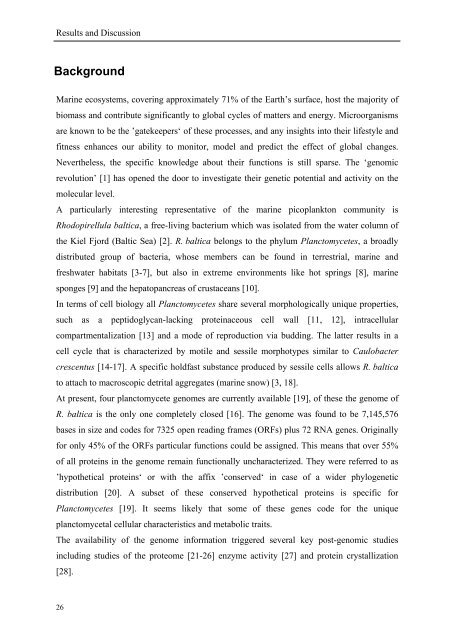a Whole Genome Array Approach - Jacobs University
a Whole Genome Array Approach - Jacobs University
a Whole Genome Array Approach - Jacobs University
Create successful ePaper yourself
Turn your PDF publications into a flip-book with our unique Google optimized e-Paper software.
Results and Discussion<br />
Background<br />
Marine ecosystems, covering approximately 71% of the Earth’s surface, host the majority of<br />
biomass and contribute significantly to global cycles of matters and energy. Microorganisms<br />
are known to be the ’gatekeepers‘ of these processes, and any insights into their lifestyle and<br />
fitness enhances our ability to monitor, model and predict the effect of global changes.<br />
Nevertheless, the specific knowledge about their functions is still sparse. The ‘genomic<br />
revolution’ [1] has opened the door to investigate their genetic potential and activity on the<br />
molecular level.<br />
A particularly interesting representative of the marine picoplankton community is<br />
Rhodopirellula baltica, a free-living bacterium which was isolated from the water column of<br />
the Kiel Fjord (Baltic Sea) [2]. R. baltica belongs to the phylum Planctomycetes, a broadly<br />
distributed group of bacteria, whose members can be found in terrestrial, marine and<br />
freshwater habitats [3-7], but also in extreme environments like hot springs [8], marine<br />
sponges [9] and the hepatopancreas of crustaceans [10].<br />
In terms of cell biology all Planctomycetes share several morphologically unique properties,<br />
such as a peptidoglycan-lacking proteinaceous cell wall [11, 12], intracellular<br />
compartmentalization [13] and a mode of reproduction via budding. The latter results in a<br />
cell cycle that is characterized by motile and sessile morphotypes similar to Caulobacter<br />
crescentus [14-17]. A specific holdfast substance produced by sessile cells allows R. baltica<br />
to attach to macroscopic detrital aggregates (marine snow) [3, 18].<br />
At present, four planctomycete genomes are currently available [19], of these the genome of<br />
R. baltica is the only one completely closed [16]. The genome was found to be 7,145,576<br />
bases in size and codes for 7325 open reading frames (ORFs) plus 72 RNA genes. Originally<br />
for only 45% of the ORFs particular functions could be assigned. This means that over 55%<br />
of all proteins in the genome remain functionally uncharacterized. They were referred to as<br />
’hypothetical proteins‘ or with the affix ’conserved‘ in case of a wider phylogenetic<br />
distribution [20]. A subset of these conserved hypothetical proteins is specific for<br />
Planctomycetes [19]. It seems likely that some of these genes code for the unique<br />
planctomycetal cellular characteristics and metabolic traits.<br />
The availability of the genome information triggered several key post-genomic studies<br />
including studies of the proteome [21-26] enzyme activity [27] and protein crystallization<br />
[28].<br />
26

















